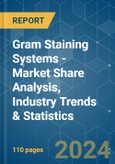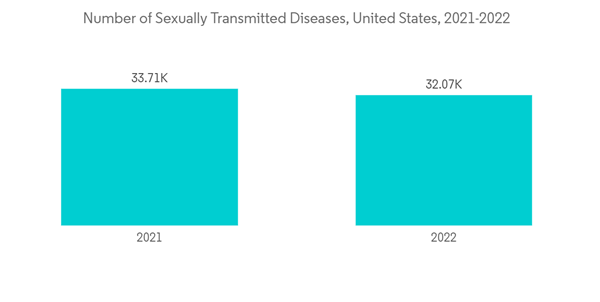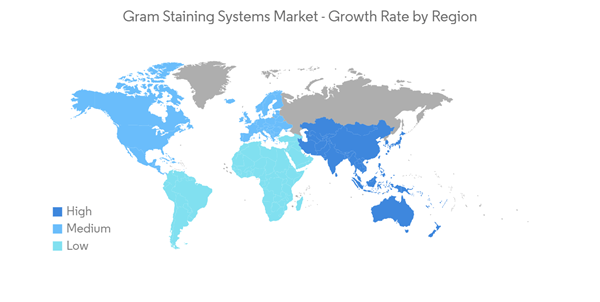The Gram Staining Systems Market is expected to register a CAGR of 6.20% during the forecast period(2024-2029).
This product will be delivered within 2 business days.
Key Highlights
- The COVID-19 pandemic had a substantial influence on the gram staining systems market due to the global lockdown as well as the partial or complete shutdown of laboratory facilities due to the massive influx of COVID-19 patients.
- For instance, as per the January 2021 update by the American Society for Microbiology, 47.5% of labs had a shortage of supplies for the detection of routine bacteria (including the bacteria causing strep throat, pneumonia, bronchitis, and urinary tract infections). Hence, COVID-19 had a significant impact on the gram staining systems market. However, with the resumption of laboratory services and decreasing cases of COVID-19, the studied market is expected to recover from the reduction of COVID-19 over the forecast period.
- The major factor attributing to the growth of the market is the increasing need for advancements in diagnostics as there is an increasing prevalence of infectious diseases. For instance, according to the data published by the World Health Organization (WHO) in the Global Tuberculosis Report 2022, most TB cases in 2021 were in the WHO regions of South-East Asia (45%), Africa (23%), and Western Pacific (18%), with smaller shares in the Eastern Mediterranean (8.1%), the Americas (2.9%) and Europe (2.2%). Hence, the rise in the prevalence of TB cases is expected to increase the demand for gram staining for the detection of TB infections and thereby fuelling the market growth.
- Additionally, technological advancements and a rise in research funding for clinical research are expected to drive market growth. There is an increase in the adoption of automated staining systems in laboratories which gained a lot of attention due to their efficiency and accuracy. For instance, as per the article published in December 2022 in Elsevier, the research indicated promising results regarding the potential for an automated algorithm for the classification of microscopic gram stain images. Furthermore, a rise in clinical studies with the utilization of various gram-staining techniques is expected to drive market growth.
- For instance, in April 2023, Sohag University sponsored a clinical trial to evaluate phenotypic and genotypic variations of Enterococcus Spp, which are gram-positive facultative anaerobic cocci arranged in short and medium chains. During the procedure, various staining techniques are conducted to identify the bacteria. Thus, due to such clinical studies, the demand for gram-staining reagents and systems are likely to increase, thereby bolstering the market growth.
- Thus, due to the rise in infectious diseases, technological advancements, and a rise in research funding for clinical research, the studied market is anticipated to witness significant growth over the forecast period. However, lack of awareness of the staining systems and many using the conventional method for staining constraints the market growth.
Gram Staining Systems Market Trends
Diagnostic Laboratories is the Fastest Growing End User Segment in the Gram Staining Systems Market
- In diagnostic laboratories, gram stain is a common test that can help diagnose the presence of a bacterial infection quickly. Gram staining is an important tool in treating patients with clinical infections in the emergency important diagnostic tool in treating patients with clinical infections in the emergency. This technique is of importance in soft tissue abscesses, lower respiratory tract infections, urinary tract infections, cervicitis, and urethritis.
- The growth of the segment is attributed to the increasing prevalence of infectious diseases, the advantages of the staining systems over the manual conventional staining procedure, and the increased funding of the clinical research field. For instance, as per the UNICEF data updated in August 2021, globally, there were over 1,400 cases of pneumonia per 100,000 children, or 1 case per 71 children every year, with the greatest incidence occurring in South Asia (2,500 cases per 100,000 children) and West and Central Africa (1,620 cases per 100,000 children). A sputum gram stain is a laboratory test used to detect bacteria in a sputum sample for the detection of pneumonia. Thus, with the increasing cases of pneumonia, the demand for its diagnosis is also expected to increase, which is further expected to boost the growth of the market over the forecast period.
- Moreover, an increase in product launches and strategic initiatives by the key players are expected to drive segment growth. For instance, in October 2022, LordsMed, the global healthcare division of Lord's Mark Industries, launched an in-vitro diagnostics (IVD) manufacturing facility at Vasai, on the outskirts of Mumbai. The 20,000-sqft facility manufactures in vitro diagnostics (IVD) and point-of-care diagnostic solutions such as analyzers, reagents for clinical biochemistry, hematology, serology, immunology, rapid testing kits (ICMR-approved antigen kits), and lab consumables.
- Thus, the laboratory reagents for clinical biochemistry include gram-staining reagents and consumables, these are commonly used for the detection of urinary tarct infections (UTIs), pneumonia, and other bacterial infections, the studied market is expected to witness a significant market growth due to such expansions of manufacturing facilities.
- Hence, due to the rise in infectious diseases, technological advancements, and a rise in research funding for clinical research, the studied segment is anticipated to witness significant growth over the forecast period.
North America Anticipated to Hold a Significant Share in the Market Over the Forecast Period
- North America is expected to hold a significant market share in the overall market throughout the forecast period. The high prevalence of infectious diseases and the established healthcare infrastructure are some of the key factors accountable for its large share in the market.
- For instance, as per the Sexually Transmitted Disease Surveillance 2021, 710,151 cases of gonorrhea were diagnosed in the United States in 2021, which was an increase from 677,769 cases in the previous year. Thus, an increase in gonorrhea cases is likely to boost the gram staining market since gonorrhea comes under gram-negative infection, which can be diagnosed under gram staining.
- Furthermore, beneficial government initiatives and increased funding for product improvements are some of the drivers expected to increase market growth. For instance, as per the National Institute of Health (NIH) March 2023 update, USD 609 million is likely to be funded for pneumonia research and related studies in 2023 in the United States. Thus, such an increase in funding for the diagnosis and testing of various infectious diseases is likely to increase the demand for gram staining and thereby drive the market growth over the forecast period.
- Furthermore, an increase in diagnostic kit launches and other strategic activities by the key players is expected to bolster market growth. For instance, in June 2022, Agilent released in vitro diagnostic regulation (IVDR)--compliant instruments, kits, and reagents for use in the European Union (EU). This launch of IVDR-compliant Class A products ensures that labs in the EU that rely on Agilent IVDR instruments, kits, and reagents in their diagnostic workflows will continue to be able to use these products without disruption. Thus, such IVD reagent launches for the detection of various bacterial infections bolster the gram staining market growth over the forecast period.
- Therefore, due to the rise in infectious diseases and a rise in research funding for clinical research, North America is anticipated to witness significant growth over the forecast period.
Gram Staining Systems Industry Overview
The gram staining systems market is competitive and consists of several major players. The major players are focusing on product development and the opening of new manufacturing facilities. Some of the companies which are currently dominating the market are ELITechGroup, bioMérieux SA, Hardy Diagnostics, F. Hoffmann-La Roche Ltd, Lorne Laboratories Limited, Labema Oy, Thermo Fisher Scientific, Merck KGaA.Additional Benefits:
- The market estimate (ME) sheet in Excel format
- 3 months of analyst support
This product will be delivered within 2 business days.
Table of Contents
1 INTRODUCTION
4 MARKET DYNAMICS
5 MARKET SEGMENTATION (Market Size by Value - USD)
6 COMPETITIVE LANDSCAPE
Methodology

LOADING...










